There are 174 species in the thrush family, and they are often soft, plump medium-sized birds. They have wide-ranging distributions, and many inhabit wooded areas. Most feed on the ground and are insectivorous but eat other creatures like worms and snails. While many thrush species are similar in behavior, they typically have varied appearances. Some may be streaky brown, and others feature blue or red plumage.
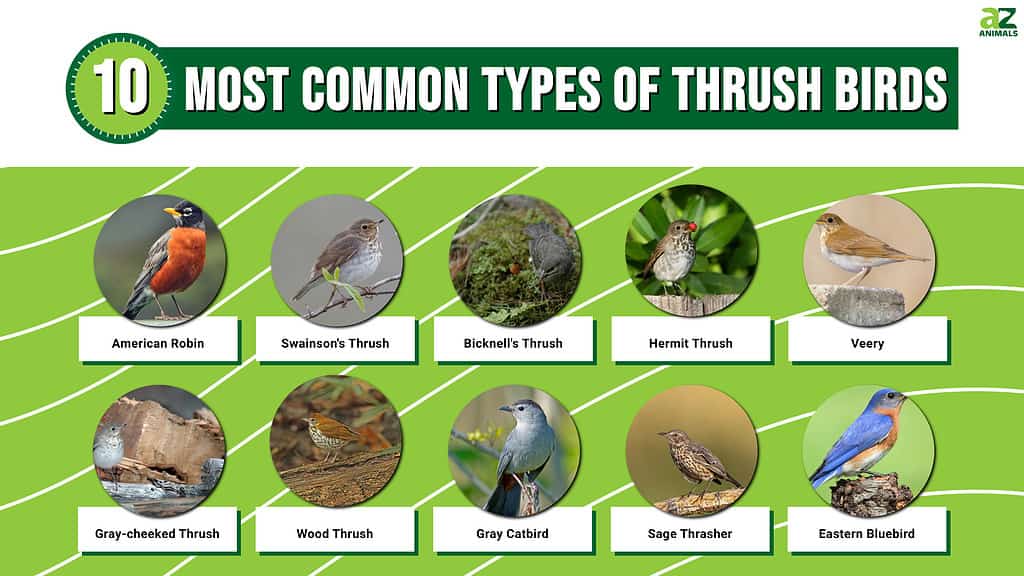
Discover the ten most common types of thrush birds in North America, including where they live and how to identify them.
American Robin
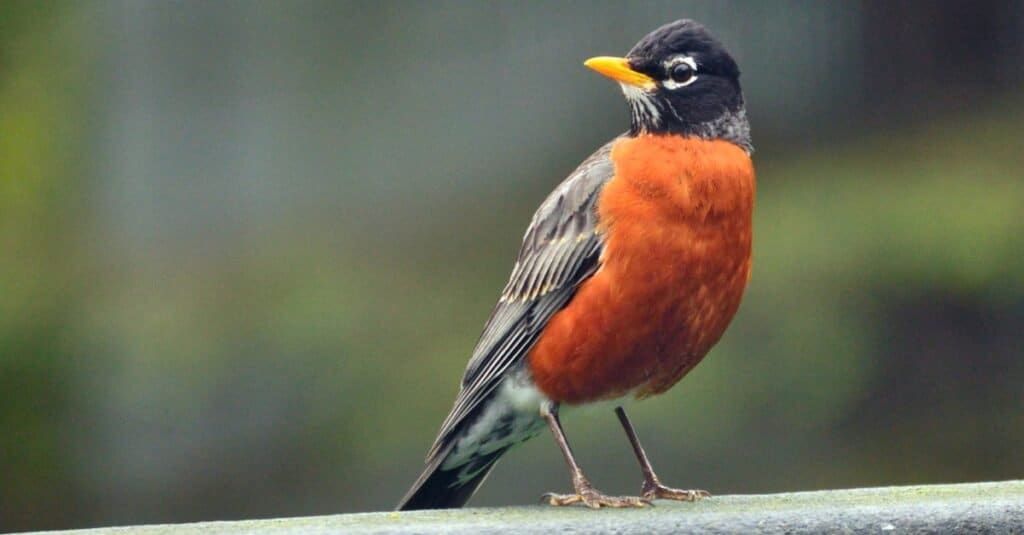
The male American robin is generally the last bird heard singing at sunset.
©iStock.com/PhotosByMSA
The American robin is the largest thrush in North America and one of the most common birds on the continent, often hanging out on suburban lawns and bird feeders. These large songbirds have round bodies, long legs, and long tails. They are grayish-brown above and orange below with dark heads. They also have white patches on their lower bellies and underneath their tails. This species lives year-round in the United States. And populations that breed throughout Canada migrate to the southern US and Mexico for winter. Look for them in backyards, fields, parks, woodlands, forests, mountains, and tundra. Use sunflower seeds, suet, and mealworms to attract robins to your yard.
Calls: Rich carols and mumbled “cucks”
Diet: Insects, berries, and earthworms
Fun Fact: They become intoxicated from eating honeysuckle berries.
Swainson’s Thrush
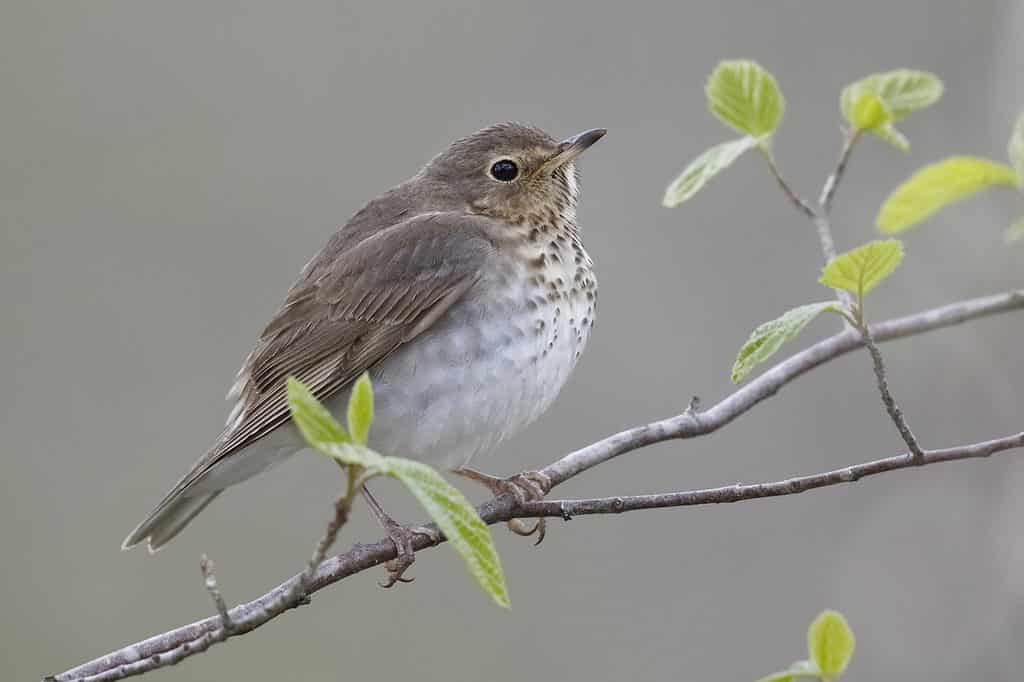
The Swainson’s thrush likes dense tree and shrub cover.
©iStock.com/BrianLasenby
The Swainson’s thrush may be difficult to spot in their dense wood habitat, but their flute-like songs brighten summer mornings. These medium-sized birds are slim with round heads and short bills. They are brown above and pale below with buffy eyering and dark chest spots. This species breeds through most of Canada and Alaska, migrates through the United States, and winters in Central and South America. You can find them in coniferous forests and streamside woodlands. Entice them to your yard by providing tree and shrub cover with ground-level birdbaths.
Calls: Flutey, spiraling melodies, and hollow peeps
Diet: Insects, berries, and fruits
Fun Fact: Males battle each other over territory with singing duels.
Bicknell’s Thrush

The Bicknell’s thrush prefers regenerating forests with undergrowth.
©iStock.com/EvanCurtis
The Bicknell’s thrush lives in remote dense forests and is difficult to distinguish due to its similarity to the gray-cheeked thrush. They are small thrushes with straight, short bills, and feature plain gray faces, pale undersides, and grayish-brown upperparts. They breed in southeastern Canada, migrate through the United State’s east coast, and winter in the West Indies. Their preferred habitats include regenerating forests with undergrowth and overgrown woodlots. This species does not typically come to backyard feeders.
Calls: Whirling nasal songs and harsh “veers”
Diet: Ants, beetles, and small fruits
Fun Fact: Both males and females mate with several partners, and their nests are filled with young from several males.
Hermit Thrush
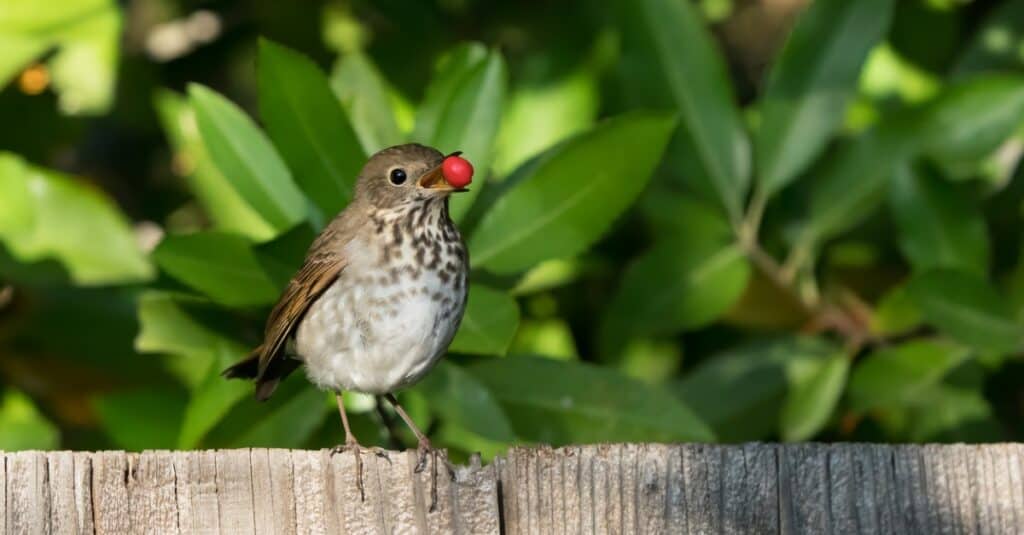
The hermit thrush sounds like a flute when it sings.
©iStock.com/Wendy/Jeff Sparks/Torquemada
This inconspicuous bird blends with the forest floor as it lurks through the understory. The hermit thrush has a chunky body with a slender bill and round head. They have rich brown heads and backs with reddish tails and pale underparts. They also have distinct brown spots on their breasts. These birds breed in Canada and the western United States and winter in the southeast and Mexico. You can find them in many habitats, including mountain forests and woodlands. However, they do not typically visit backyards unless there are berry bushes on your property.
Calls: Clear, musical songs and low tucks
Diet: Insects, spiders, and berries
Fun Fact: They shake grass with their feet to find insects.
Veery
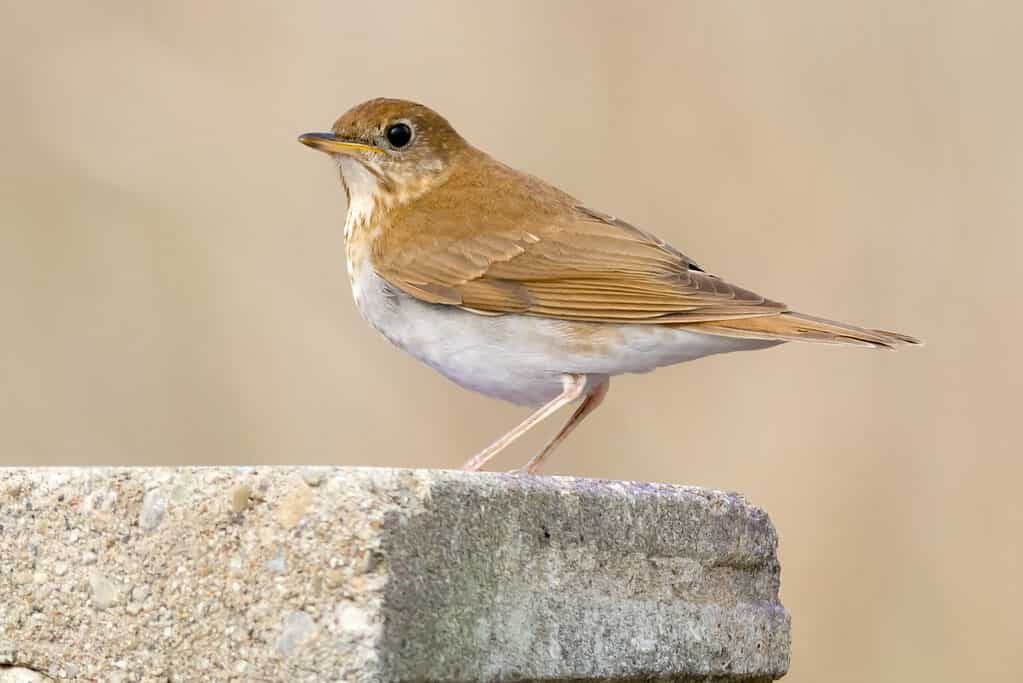
The veery features chestnut and cinnamon-colored plumage.
©iStock.com/PaulReevesPhotography
The veery gets its name from the descending “veer” song the male produces when defending its territory. They are plump medium-sized thrushes with round heads and straight bills. They are chestnut or cinnamon brown above and pale below with buffy-orange throats. This species breeds in southern Canada, migrates through the eastern United States and Central America, and winters in central South America. They live in dense, moist woodlands near a water source and are not common backyard birds.
Calls: ethereal, downward-spiraling songs and whistled calls
Diet: Insects and berries
Fun Fact: Veeries can fly up to 160 miles in one night.
Gray-cheeked Thrush

The gray-cheeked thrush breeds in northern Canada and winters in South America.
©iStock.com/creighton359
The gray-cheeked thrush is an elusive bird and one of the hardest thrushes to identify. They have a compact size with long wings and short bills. They are grayish-brown above and gray below, with dark spots on the breast and throat. This species breeds in northern Canada, migrates through the eastern half of the United States, and winters in Northern South America. You will often find them in shrubby or open wooded habitats, and they are not known for visiting feeders.
Calls: Thin, reedy notes and high-pitched “vreer” calls
Diet: Insects, berries, wild fruits
Fun Fact: Small populations breed in eastern Russia.
Wood Thrush
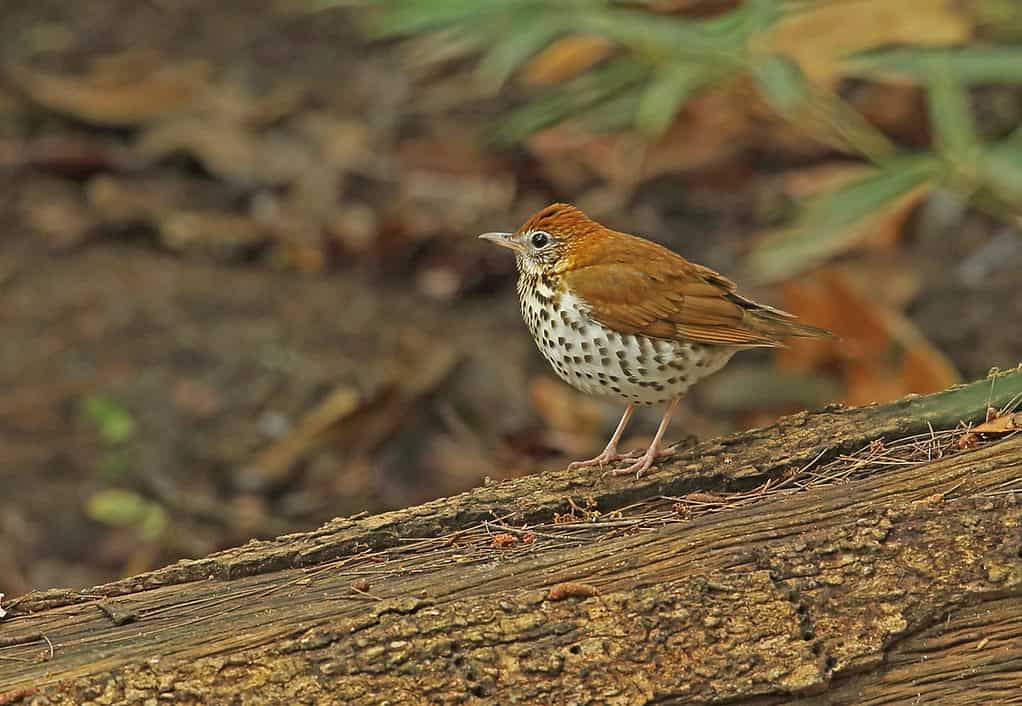
Wood thrushes are likely to inhabit parks and suburbs.
©iStock.com/Neil bowman
The wood thrush is not as shy and elusive as other thrush and is more likely to be spotted in parks or suburbs. This species has a plump belly, a short tail, and a straight bill. They have deep reddish-brown plumage above and white below, with distinctive black spots on their chests and sides. The wood thrush breeds in the eastern half of the United States and winters in Central America. And you can find them in mature forests, town parks, and tropical lowland forests. These birds are unlikely to visit backyards, but you may be able to hear their vocalizations if you live next to a wooded area.
Calls: Rich, flute-like melodies and sharp “pit-pit” calls
Diet: Leaf litter invertebrates and fruits
Fun Fact: Due to its Y-shaped voicebox, the wood thrush can harmonize with itself.
Gray Catbird
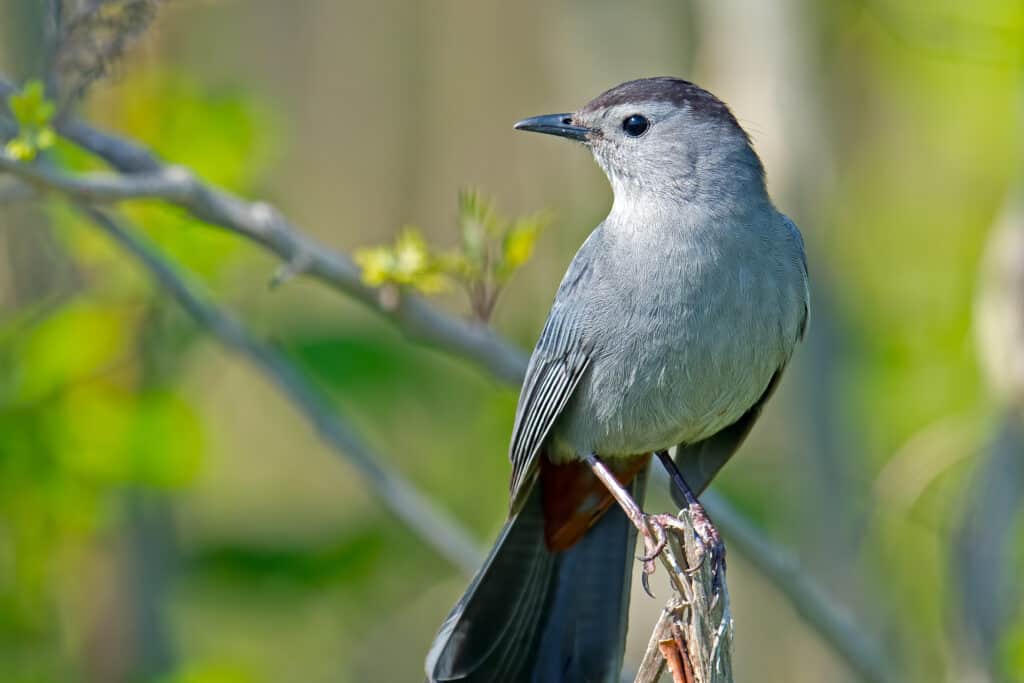
While this species does not face any imminent threats, it may be susceptible to the future effects of urbanization and climate change.
©Brian E. Kushner/Shutterstock.com
The gray catbird produces a mewing call, not unlike a cat (hence the name). They are medium-sized and slender, featuring long, rounded tails and narrow bills. These birds are slate gray with black caps, black tails, and reddish-brown tail undersides. They breed throughout most of the United States except for the far west and winter in the Southeast US and Central America. Some populations live year-round along the east coast. You can find them energetically bouncing through dense shrubs and thickets near roadsides, farmland, and residential areas. You can attract them by planting shrubs and fruit-bearing trees in your yard.
Calls: Long, irregular mechanical notes and cat-like mewing
Diet: Insects and fruits
Fun Fact: One gray catbird song can last up to ten minutes.
Sage Thrasher
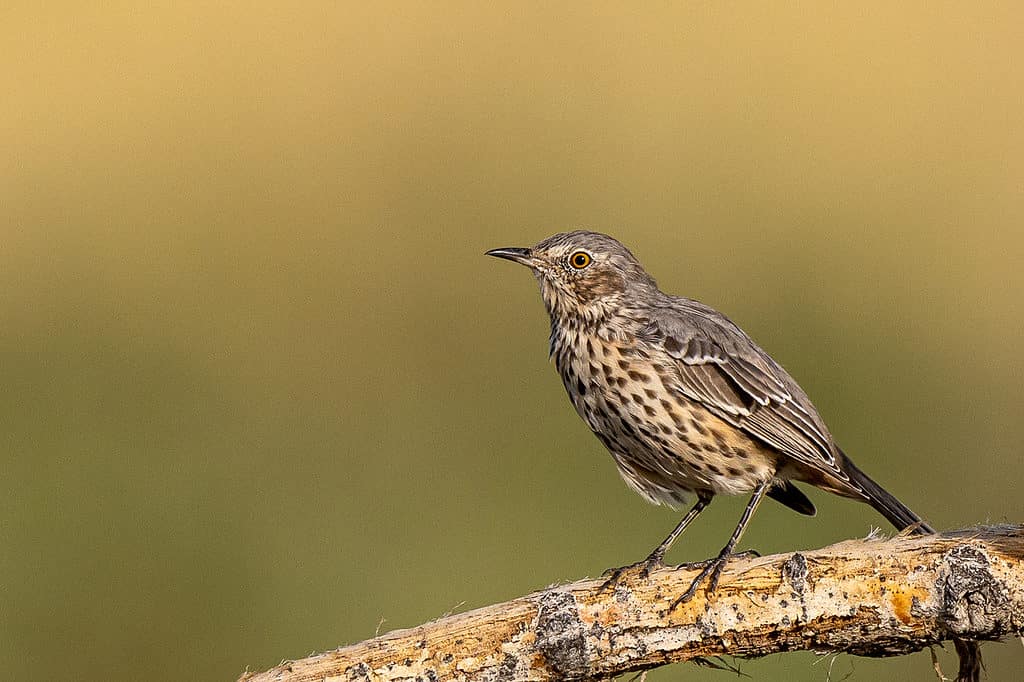
Sage thrashers live in shrubsteppe in the open spaces out west.
©iStock.com/Jeff Edwards
The sage thrasher is the smallest of the species and inhabits sagebrush steppe out west. They have long legs and tails for their size, but their bills are much shorter than other thrashers. These birds have pale gray plumage, dark brown spotting, white wingbars, and white tail feathers. They also have yellow irises. Sage thrashers breed in the western United States and winter in the Southwest US and Mexico. They live exclusively in shrubsteppe habitats in the vast, open spaces of the west.
Calls: Sweet continuous warbles and deep chuck calls
Diet: Terrestrial insects, arthropods, and berries
Fun Fact: They can sing for 20 minutes without taking a break.
Eastern Bluebird
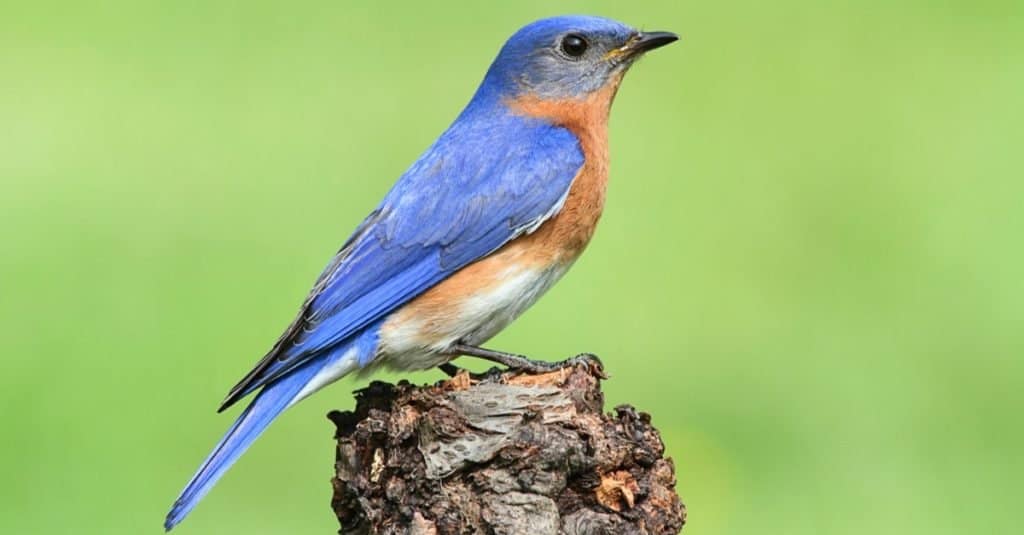
Eastern bluebirds are the most common bluebirds in North America.
©Steve Byland/Shutterstock.com
These brilliant royal blue birds are the most widespread bluebirds on the continent. They have small bodies with big, round heads and large eyes. And they are deep blue above and rusty red below, with white lower bellies. The eastern bluebird lives year-round in the southeastern United States and parts of Mexico, but some populations breed in the Northeast. These birds live in open country near trees, like pastures, fields, parks, and backyards. The bluebird is a familiar feather friend at backyard feeders, especially if there are mealworms.
Calls: Soft warbles and liquid musical calls
Diet: Insects, fruits, and small reptiles
Fun Fact: Males attract a mate by bringing nest material to the hole.
Summary of 10 Most Common Types of Thrush Birds
| Type of Thrush | Location | Habitat |
|---|---|---|
| American Robin | United States; some breed in Canada but winter in the southern US and Mexico. | Backyards, fields, parks, woodlands, forests, mountains, and tundra. |
| Swainson’s Thrush | Breeds in Canada and Alaska; migrates down to Central and South America in winter. | Coniferous forests and streamside woodlands. |
| Bicknell’s Thrush | Breeds in southeastern Canada; winters in the West Indies. | Regenerating forests with undergrowth and overgrown woodlots. |
| Hermit Thrush | Breeds in Canada and western US; winters in southeast US and Mexico. | Mountain forests and woodlands. |
| Veery | Breeds in southern Canada; migrates through eastern US and Central America; winters in central South America. | Dense, moist woodlands near a water source. |
| Gray-cheeked Thrush | Breeds in northern Canada; migrates through eastern US; winters in northern South America. | Shrubby or open wooded habitats. |
| Wood Thrush | Breeds in eastern US; winters in Central America. | Mature forests, town parks, and tropical lowland forests. |
| Sage Thrasher | Breeds in western US; winters in the southwest US and Mexico. | Shrub steppe habitats in the vast, open spaces of the west. |
| Eastern Bluebirds | Lives year-round in the southeastern US and parts of Mexico; some breed in the northeast. | Open country near trees, like pastures, fields, parks, and backyards. |
The photo featured at the top of this post is © iStock.com/Jeff Edwards
Sources
- BioOne Complete, Available here: https://bioone.org/journals/the-wilson-bulletin/volume-117/issue-1/04-013/A-PRACTICAL-MODEL-OF-BICKNELLS-THRUSH-DISTRIBUTION-IN-THE-NORTHEASTERN/10.1676/04-013.full
- IUCN RedList, Available here: https://www.iucnredlist.org/
- The Cornell Lab of Ornithology, Available here: https://www.birds.cornell.edu/home/
Thank you for reading! Have some feedback for us? Contact the AZ Animals editorial team.






